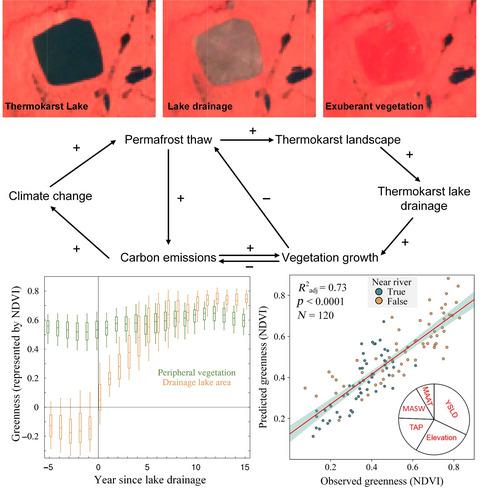当前位置:
X-MOL 学术
›
Glob. Change Biol.
›
论文详情
Our official English website, www.x-mol.net, welcomes your
feedback! (Note: you will need to create a separate account there.)
Vegetation grows more luxuriantly in Arctic permafrost drained lake basins
Global Change Biology ( IF 10.8 ) Pub Date : 2021-08-19 , DOI: 10.1111/gcb.15853 Yating Chen 1, 2 , Aobo Liu 1, 2 , Xiao Cheng 2
Global Change Biology ( IF 10.8 ) Pub Date : 2021-08-19 , DOI: 10.1111/gcb.15853 Yating Chen 1, 2 , Aobo Liu 1, 2 , Xiao Cheng 2
Affiliation

|
As Arctic warming, permafrost thawing, and thermokarst development intensify, increasing evidence suggests that the frequency and magnitude of thermokarst lake drainage events are increasing. Presently, we lack a quantitative understanding of vegetation dynamics in drained lake basins, which is necessary to assess the extent to which plant growth in thawing ecosystems will offset the carbon released from permafrost. In this study, continuous satellite observations were used to detect thermokarst lake drainage events in northern Alaska over the past 20 years, and an advanced temporal segmentation and change detection algorithm allowed us to determine the year of drainage for each lake. Quantitative analysis showed that the greenness (normalized difference vegetation index [NDVI]) of tundra vegetation growing on wet and nutrient-rich lake sediments increased approximately 10 times faster than that of the peripheral vegetation. It takes approximately 5 years (4–6 years for the 25%–75% range) for the drainage lake area to reach the greenness level of the peripheral vegetation. Eventually, the NDVI values of the drained lake basins were 0.15 (or 25%) higher than those of the surrounding areas. In addition, we found less lush vegetation in the floodplain drained lake basins, possibly due to water logging. We further explored the key environmental drivers affecting vegetation dynamics in and around the drained lake basins. The results showed that our multivariate regression model well simulated the growth dynamics of the drainage lake ecosystem ( , p < .001) and peripheral vegetation (
, p < .001) and peripheral vegetation ( , p < .001). Among climate variables, moisture variables were more influential than temperature variables, indicating that vegetation growth in this area is susceptible to water stress. Our study provides valuable information for better modeling of vegetation dynamics in thermokarst lake areas and provides new insights into Arctic greening and carbon balance studies as thermokarst lake drainage intensifies.
, p < .001). Among climate variables, moisture variables were more influential than temperature variables, indicating that vegetation growth in this area is susceptible to water stress. Our study provides valuable information for better modeling of vegetation dynamics in thermokarst lake areas and provides new insights into Arctic greening and carbon balance studies as thermokarst lake drainage intensifies.
中文翻译:

北极多年冻土流失的湖盆植被更加茂盛
随着北极变暖、永久冻土融化和热岩溶发育的加剧,越来越多的证据表明,热岩溶湖排水事件的频率和幅度正在增加。目前,我们缺乏对排水湖盆地植被动态的定量了解,这对于评估解冻生态系统中植物生长将抵消永久冻土释放的碳的程度是必要的。在这项研究中,连续卫星观测用于检测过去 20 年来阿拉斯加北部的热岩溶湖排水事件,先进的时间分割和变化检测算法使我们能够确定每个湖泊的排水年份。定量分析表明,生长在潮湿和营养丰富的湖泊沉积物中的苔原植被的绿度(归一化差异植被指数[NDVI])比外围植被的增长速度快约10倍。排水湖区大约需要 5 年(25%~75% 范围为 4~6 年)才能达到外围植被的绿度水平。最终,排干湖盆的 NDVI 值比周边地区高 0.15(或 25%)。此外,我们发现洪泛区排水湖盆的植被较少,可能是由于内涝。我们进一步探讨了影响排水湖盆地及其周围植被动态的关键环境驱动因素。 , p < .001) 和外围植被 (
, p < .001) 和外围植被 (  , p < .001)。在气候变量中,水分变量比温度变量的影响更大,表明该地区的植被生长容易受到水分胁迫的影响。我们的研究为更好地模拟热岩溶湖地区的植被动态提供了有价值的信息,并为随着热岩溶湖排水的加强而对北极绿化和碳平衡研究提供了新的见解。
, p < .001)。在气候变量中,水分变量比温度变量的影响更大,表明该地区的植被生长容易受到水分胁迫的影响。我们的研究为更好地模拟热岩溶湖地区的植被动态提供了有价值的信息,并为随着热岩溶湖排水的加强而对北极绿化和碳平衡研究提供了新的见解。
更新日期:2021-10-15
 , p < .001) and peripheral vegetation (
, p < .001) and peripheral vegetation ( , p < .001). Among climate variables, moisture variables were more influential than temperature variables, indicating that vegetation growth in this area is susceptible to water stress. Our study provides valuable information for better modeling of vegetation dynamics in thermokarst lake areas and provides new insights into Arctic greening and carbon balance studies as thermokarst lake drainage intensifies.
, p < .001). Among climate variables, moisture variables were more influential than temperature variables, indicating that vegetation growth in this area is susceptible to water stress. Our study provides valuable information for better modeling of vegetation dynamics in thermokarst lake areas and provides new insights into Arctic greening and carbon balance studies as thermokarst lake drainage intensifies.
中文翻译:

北极多年冻土流失的湖盆植被更加茂盛
随着北极变暖、永久冻土融化和热岩溶发育的加剧,越来越多的证据表明,热岩溶湖排水事件的频率和幅度正在增加。目前,我们缺乏对排水湖盆地植被动态的定量了解,这对于评估解冻生态系统中植物生长将抵消永久冻土释放的碳的程度是必要的。在这项研究中,连续卫星观测用于检测过去 20 年来阿拉斯加北部的热岩溶湖排水事件,先进的时间分割和变化检测算法使我们能够确定每个湖泊的排水年份。定量分析表明,生长在潮湿和营养丰富的湖泊沉积物中的苔原植被的绿度(归一化差异植被指数[NDVI])比外围植被的增长速度快约10倍。排水湖区大约需要 5 年(25%~75% 范围为 4~6 年)才能达到外围植被的绿度水平。最终,排干湖盆的 NDVI 值比周边地区高 0.15(或 25%)。此外,我们发现洪泛区排水湖盆的植被较少,可能是由于内涝。我们进一步探讨了影响排水湖盆地及其周围植被动态的关键环境驱动因素。
 , p < .001) 和外围植被 (
, p < .001) 和外围植被 (  , p < .001)。在气候变量中,水分变量比温度变量的影响更大,表明该地区的植被生长容易受到水分胁迫的影响。我们的研究为更好地模拟热岩溶湖地区的植被动态提供了有价值的信息,并为随着热岩溶湖排水的加强而对北极绿化和碳平衡研究提供了新的见解。
, p < .001)。在气候变量中,水分变量比温度变量的影响更大,表明该地区的植被生长容易受到水分胁迫的影响。我们的研究为更好地模拟热岩溶湖地区的植被动态提供了有价值的信息,并为随着热岩溶湖排水的加强而对北极绿化和碳平衡研究提供了新的见解。











































 京公网安备 11010802027423号
京公网安备 11010802027423号